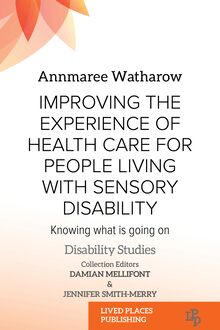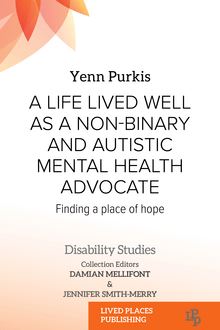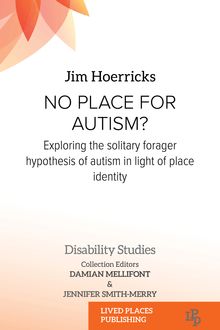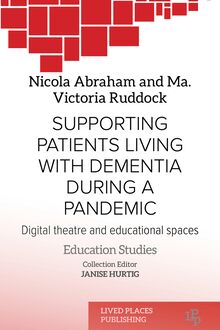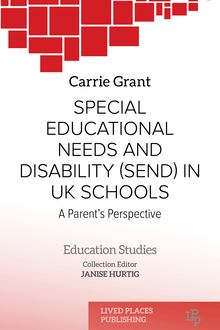-
 Univers
Univers
-
 Ebooks
Ebooks
-
 Livres audio
Livres audio
-
 Presse
Presse
-
 Podcasts
Podcasts
-
 BD
BD
-
 Documents
Documents
-
- Cours
- Révisions
- Ressources pédagogiques
- Sciences de l’éducation
- Manuels scolaires
- Langues
- Travaux de classe
- Annales de BEP
- Etudes supérieures
- Maternelle et primaire
- Fiches de lecture
- Orientation scolaire
- Méthodologie
- Corrigés de devoir
- Annales d’examens et concours
- Annales du bac
- Annales du brevet
- Rapports de stage
La lecture à portée de main
Vous pourrez modifier la taille du texte de cet ouvrage
Découvre YouScribe en t'inscrivant gratuitement
Je m'inscrisDécouvre YouScribe en t'inscrivant gratuitement
Je m'inscrisEn savoir plus
Vous pourrez modifier la taille du texte de cet ouvrage
En savoir plus

Description
Disability or difference? How autism is understood varies from place to place.
Drawn from lived experience, this book explores the question of what autism is, and how it is best viewed in society. Dr Jim Hoerricks PhD – an academic and non-verbal autistic person – interrogates different models of disability, and considers how autism might be seen as a difference in human experience, in light of the need for accommodations and structural supports.
Positioning autism as both a set of traits and an identity, No place for autism? asks what can be done to give place for autistic people and communities.
1: Introduction
2: What is autism?
3: When is autism?
4: Where is autism?
5: Who is autistic?
6: Why autism?
Sujets
Informations
| Publié par | Lived Places Publishing |
| Date de parution | 22 février 2023 |
| Nombre de lectures | 0 |
| EAN13 | 9781915271822 |
| Langue | English |
Informations légales : prix de location à la page 0,1250€. Cette information est donnée uniquement à titre indicatif conformément à la législation en vigueur.
Extrait
NO PLACE FOR AUTISM?
Jim Hoerricks, PhD
NO PLACE FOR AUTISM?
Exploring the solitary forager hypothesis of autism in light of place identity
The Disability Studies Collection
Collection editors
Dr Damian Mellifont &
Dr Jen Smith-Merry
First published in 2023 by Lived Places Publishing.
All rights reserved. No part of this publication may be reproduced, stored in a retrieval system, or transmitted in any form or by any means, electronic, mechanical, photocopying, recording or otherwise, without prior permission in writing from the publisher.
The authors and editors have made every effort to ensure the accuracy of information contained in this publication, but assumes no responsibility for any errors, inaccuracies, inconsistencies and omissions. Likewise, every effort has been made to contact copyright holders. If any copyright material has been reproduced unwittingly and without permission the Publisher will gladly receive information enabling them to rectify any error or omission in subsequent editions.
Copyright © 2023 Lived Places Publishing
British Library Cataloguing in Publication Data
A CIP record for this book is available from the British Library
ISBN: 9781915271815 (pbk)
ISBN: 9781915271839 (ePDF)
ISBN: 9781915271822 (ePUB)
The right of Jim Hoerricks to be identified as the Author of this work has been asserted by them in accordance with the Copyright, Design and Patents Act 1988.
Cover design by Fiachra McCarthy
Book design by Rachel Trolove of Twin Trail Design
Typeset by Newgen Publishing UK
Lived Places Publishing
Long Island
New York 11789
www.livedplacespublishing.com
Abstract
Guided from a lived experience point of view, No place for autism? explores how what we consider to be autism can vary from place to place. Is it a disability? If it is a disability, what is the better model for framing the authentic autistic experience: the medical model, the social model, or the ecological-enactive model of disability? If it is simply a difference in the human experience, what about structural supports and accommodations? The answers might surprise you.
Working from the premise that the autistic system is the result of 50,000 years of natural selection, the author posits that the autistic system works as designed and then unpacks the design in a highly detailed fashion, diving deep into questions of autistic identity across time and place. Noting that autism is both a set of traits and an identity, implications of this design-centric approach are given from the standpoint of place. That is to say, are there places and spaces where one might feel more or less disabled? If so, why… and what can be done to give place to autistic people and autistic communities?
Keywords
Asperger’s Disorder; Autism Spectrum Disorder (ASD); autistic; disability studies; neurodivergent; special education; teaching studies
Contents
1 Introduction 1
Learning objective 1
End of chapter activity 29
Key vocabulary and terms 30
Building background knowledge
33 2 What is autism? 35
Learning objective 35
End of chapter activity 60
Key vocabulary, terms, and people 61
Building background knowledge
63 3 When is autism? 65
Learning objective 65
End of chapter activity 84
Key vocabulary, terms, and people 85
Building background knowledge
87 4 Where is autism? 89
Learning objective 89
End of chapter activity 103
Key vocabulary, terms, and people 107
Building background knowledge 109
5 Who is autistic? 113
Learning objective 113
Key vocabulary, terms, and people 140
Building background knowledge
142 6 Why autism? 145
Learning objective 145
Key vocabulary, terms, and people 167
Building background knowledge
169 7 Summary 171
Review 171
A cohesive view of autism 174
Final thoughts 176
References 178
Index 201
1 Introduction
Learning objective
Students will be able to synthesize the lived experience of autistic adults in the context of place, based upon the supplied descriptions and related research.
Activity
At the end of the chapter, students will engage in an activity that explores the evolution of their intersectional identities as their place or context has changed over time.
Key vocabulary, terms, references, and background knowledge-building resources
You will find explanations of key vocabulary and terms at the end of each chapter, together with the chapter’s references and knowledge-building resources.
Meet the author
Hello and welcome. My name is Jim Hoerricks, the author of this text. I’ll be your facilitator through this experience. I happen to be autistic and non-verbal . I don’t just mention this in passing. It is an important factor in this text. You see, for many years the greater autistic community has asked that future work focus on those areas that improve autistic people’s day-to-day lives. Also, that there needs to be more involvement from autistic people in autism research, as well as the creation and publication of materials that deal with autism. This work is an attempt to do just that – to feature the work of an autistic researcher and educator with a diverse range of lived experiences. These experiences reinforce the central premise of this text, that how one experiences autism can vary depending upon one’s intersecting identities as well as one’s place on this planet.
Allow me to explain. As I write this, I’m over 50 years old and living in the rural mountains of northern Los Angeles County, California. My experience of being autistic thus spans times when autism wasn’t widely recognized in the world to the present, where we are again questioning what it means to be autistic. I was originally diagnosed in 2012 with Sensory Processing Disorder and Sensory Integration Disorder (both related to my confused processing of incoming sensory information), and Asperger’s Disorder (related to my processing of the world). With the change from DSM -IV-TR to DSM-5, these individual diagnoses were changed within the medical records system of my health care provider to the single diagnosis of Autism Spectrum Disorder (ASD). Like many autistic people, I have many other health issues – also known as co-morbidities. For example, I am alexithymic and histamine intolerant, which has a profound impact on how I experience the social world. Alexithymia is not only an inability to accurately describe how one feels, but an inability to correctly attribute the source of those feelings. For a hyper-empathic person, one who is constantly absorbing the feelings and energy from around them, this can be quite problematic. I’ll share more on this later in the book.
Academically, I have bachelor’s and master’s degrees in Organizational Leadership, a master’s degree in Education Instructional Design, a master’s degree in Special Education , and a PhD in Education. My dissertation focused on the sensory environments on university campuses in the US that are so hostile to the autistic system that more than 60 percent of first-year autistic students voluntarily withdraw in their first semester. From the resulting data, I suggested four easy-to-accomplish tasks that college administrations could do to improve outcomes for this vulnerable population of learners. I was able to accomplish these academic achievements after learning to work in the English language in my late twenties. As a non-verbal autistic person growing up in a culturally diverse part of an English-speaking country, I did not acquire a verbal language as a child.
As a child and a young adult, I used echolalia to communicate vocally. I had a very low success rate with the dozen or so words and phrases I had memorized. I lived in a working-class suburb of migrants who largely came from northern and eastern Europe, Mexico, and Armenia. Thus, my basket of phrases contained a range of languages, which further complicated my language development. German, making more sense to me than English, was the first language that I attempted to learn. It helped that I had German-speaking friends who were largely supportive of my efforts.
I managed to graduate from high school in the top 25 of my class of almost 500 students despite being functionally illiterate. This fact has been the largest factor informing my decision to become an educator. But first, I had to learn to operate in the world of the verbal.
As my ability to process verbal language developed in my late twenties, I found work as a forensic scientist. Later, after tasking my autistic brain to turn my new vocation into my special interest, I wrote a book on the uses of Photoshop for digital multimedia forensic science as a giant info-dump. It became a best-seller and is still available for sale almost 15 years after its initial publication. As I dove deep into my new special interest, I developed hyper-specialized courses around the topics in that field. These were info-dumps full of complex, hands-on exercises. Requests to host these courses took me all over the world, teaching students from over 40 countries. Then, the COVID-19 pandemic happened and shut down in-person training. With my college and professional experience around creating and facilitating engaging learning events, I transitioned into a similar career, one that the government deemed more essential than adult professional development. I enrolled in a local college’s teacher preparation program and am now a credentialed special education teacher and literacy specialist.
Despite this seemingly busy blur of a schedule, I’ve found the time to be married for 25 years. I am a parent to an array of neurodivergent children. Through it all, our family has found a way to accommodate each other’s autism, ADHD, anxiety, and OCD. Being a parent of neurodivergent children, I understand and can empathize with the Autism Parent TM movement. Yet, I don’t identify within that space as the Autism Parent TM is often a neurotypical person seeking help in understanding and supporting
-
 Univers
Univers
-
 Ebooks
Ebooks
-
 Livres audio
Livres audio
-
 Presse
Presse
-
 Podcasts
Podcasts
-
 BD
BD
-
 Documents
Documents
-
Jeunesse
-
Littérature
-
Ressources professionnelles
-
Santé et bien-être
-
Savoirs
-
Education
-
Loisirs et hobbies
-
Art, musique et cinéma
-
Actualité et débat de société
-
Jeunesse
-
Littérature
-
Ressources professionnelles
-
Santé et bien-être
-
Savoirs
-
Education
-
Loisirs et hobbies
-
Art, musique et cinéma
-
Actualité et débat de société
-
Actualités
-
Lifestyle
-
Presse jeunesse
-
Presse professionnelle
-
Pratique
-
Presse sportive
-
Presse internationale
-
Culture & Médias
-
Action et Aventures
-
Science-fiction et Fantasy
-
Société
-
Jeunesse
-
Littérature
-
Ressources professionnelles
-
Santé et bien-être
-
Savoirs
-
Education
-
Loisirs et hobbies
-
Art, musique et cinéma
-
Actualité et débat de société
- Cours
- Révisions
- Ressources pédagogiques
- Sciences de l’éducation
- Manuels scolaires
- Langues
- Travaux de classe
- Annales de BEP
- Etudes supérieures
- Maternelle et primaire
- Fiches de lecture
- Orientation scolaire
- Méthodologie
- Corrigés de devoir
- Annales d’examens et concours
- Annales du bac
- Annales du brevet
- Rapports de stage
